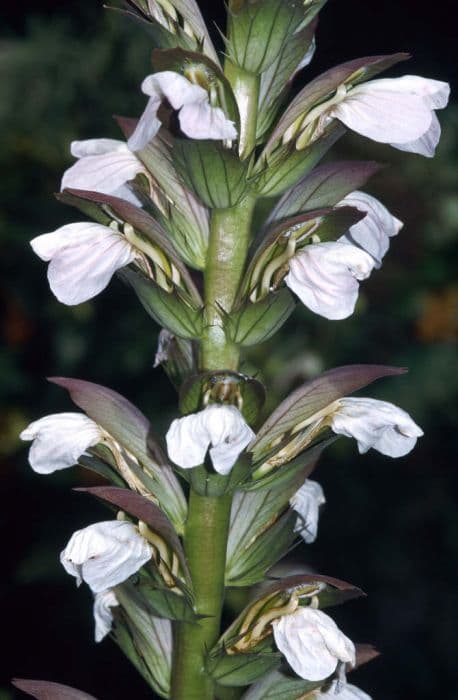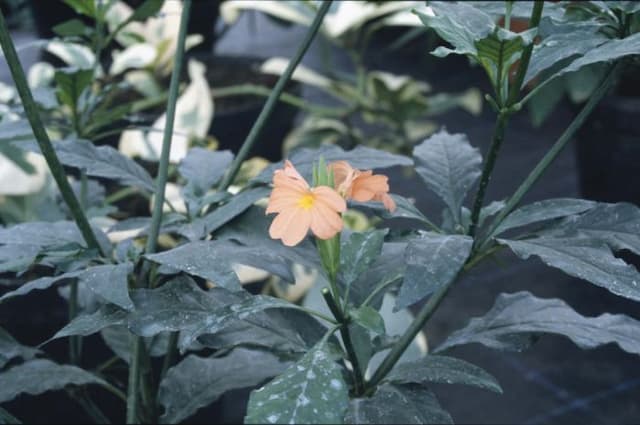Bengal Clock Vine Thunbergia grandiflora

ABOUT
The plant commonly referred to as the Bengal Clock Vine or Blue Trumpet Vine is known for its magnificent floral display and climbing habit. It possesses a lush, verdant foliage consisting of heart-shaped leaves that provide a dense, green backdrop to its showy blooms. The flowers are large, captivating, and trumpet-shaped, showcasing a vivid sky-blue to purplish shade with a paler or whitish throat. These blooms are typically arranged in clusters that gracefully drape or hang, adding to the plant's overall aesthetic appeal. Each individual flower can be strikingly prominent, presenting a bold visual display that can easily become a focal point in a garden setting. The plant's vigorous growth allows it to cover structures with ease, making it an excellent candidate for trellises, arbors, and fences where it can freely showcase its cascading flowers. The Bengal Clock Vine's beauty is further enhanced by its relatively long bloom period, which, under appropriate conditions, allows an ongoing exhibition of its stunning flowers. This eye-catching plant is a favorite among gardeners who wish to create a tropical atmosphere in their outdoor spaces. Its ability to attract hummingbirds and butterflies adds another layer of dynamic beauty to wherever it is cultivated, turning any garden into a lively haven for wildlife and a delightful retreat for those who appreciate nature's splendor.
About this plant
 Names
NamesFamily
Acanthaceae
Synonyms
Bengal Clock Vine, Blue Trumpet Vine, Blue Thunbergia, Sky Flower, Skyvine
Common names
Flemingia grandiflora, Hemiphragma grandiflorum, Meyenia grandiflora, Thunbergia adenophora.
 Toxicity
ToxicityTo humans
The Blue Skyflower (Thunbergia grandiflora) is not widely known for its toxicity to humans. There is limited documentation on its effects if ingested, and it is generally not considered a hazardous plant. However, as with any plant, individual allergies or sensitivities could potentially cause adverse reactions. Always use caution and consult with a medical professional or a poison control center if ingestion occurs and symptoms present.
To pets
The Blue Skyflower (Thunbergia grandiflora) is not commonly listed as a toxic plant to pets, such as dogs and cats. It is generally not recognized for having poisonous properties. However, ingestion of plants can sometimes cause gastrointestinal upset in pets, such as vomiting or diarrhea. If you suspect your pet has ingested a part of the plant and is showing symptoms, it is advisable to seek veterinary care.
 Characteristics
CharacteristicsLife cycle
Perennials
Foliage type
Evergreen
Color of leaves
Green
Flower color
Blue
Height
20 feet (6 meters)
Spread
10 feet (3 meters)
Plant type
Climber
Hardiness zones
10
Native area
Asia
Benefits
 General Benefits
General Benefits- Aesthetic Appeal: Thunbergia grandiflora, commonly known as Bengal Clock Vine, adds visual interest to gardens and landscapes with its lush, green foliage and vibrant blue flowers.
- Habitat for Wildlife: The flowers of the Bengal Clock Vine provide nectar resources for a variety of pollinators, including bees and hummingbirds.
- Screening Plant: Its rapid and dense growth habit makes it suitable for use as a privacy screen or to cover unsightly areas such as fences or walls.
- Shade Provider: Larger specimens can create shaded areas in gardens which can help in cooling the surroundings and providing shelter from the sun.
- Erosion Control: The plant's dense foliage and root system can help stabilize soil, reducing erosion on slopes and banks.
- Focal Point for Landscaping: Due to its striking flowers and trailing growth, it can serve as a focal point in landscape design.
- Adaptability: The Bengal Clock Vine is adaptable to a range of soil types and can be grown in various climates, making it a versatile choice for gardeners.
- Fast Growth: It has a fast growth rate which allows for quick coverage and gratification for gardeners looking to establish a green space rapidly.
 Medical Properties
Medical Properties- Anti-inflammatory: Thunbergia grandiflora has been used in traditional medicine systems to reduce inflammation.
- Antipyretic: It has been claimed to have properties that help in reducing fever.
- Wound healing: The plant is sometimes applied topically for its purported ability to promote wound healing.
- Antimicrobial: There are suggestions that Thunbergia grandiflora has antimicrobial activities against certain pathogens.
 Air-purifying Qualities
Air-purifying QualitiesThis plant is not specifically known for air purifying qualities.
 Other Uses
Other Uses- Thunbergia grandiflora, commonly known as Bengal Clockvine, can be used for creating shade in garden spaces as it rapidly covers arbors and pergolas with its dense foliage.
- This plant serves as a living screen for privacy when grown along fences or on trellises in urban and suburban settings.
- The vine's ability to grow on various supports makes it suitable for hiding unsightly structures like sheds or old buildings by draping them with its lush leaves and flowers.
- Innovatively, Bengal Clockvine can be trained to grow into decorative shapes or living sculptures in theme parks or large gardens.
- Its quick-growing nature allows it to be used in theater and film sets to create a tropical or jungle-like ambiance without the need for artificial plants.
- Bengal Clockvine's sprawling habit makes it useful for covering and stabilizing slopes or banks that are prone to erosion.
- Some gardeners use the vine for covering the ground in large areas where other plants may not thrive due to poor soil conditions.
- Its attractive flowers can be used as a natural backdrop for photo shoots or outdoor events such as weddings and garden parties.
- The strong vines of the Bengal Clockvine are sometimes used in crafting or weaving to create rustic garden decorations or supports for other plants.
- In creative gardening, sections of the vine can be used as a natural 'curtain' to delineate different areas of a garden or to create a sense of mystery by partially obscuring the view to a hidden garden nook.
Interesting Facts
 Feng Shui
Feng ShuiThe Blue Skyflower is not used in Feng Shui practice.
 Zodiac Sign Compitability
Zodiac Sign CompitabilityThe Blue Skyflower is not used in astrology practice.
 Plant Symbolism
Plant Symbolism- Endurance and Persistence: Thunbergia grandiflora is a vigorously growing vine that is known for its ability to spread and cover extensive areas. This growth habit symbolizes the qualities of endurance and the persistence to overcome obstacles.
- Cherished Relationships: Also known as Blue Skyflower, its lush foliage and captivating blooms are symbolic of the beauty and fullness that cherished relationships bring into one's life.
- Protection: The way the plant creates a sheltering canopy when it grows over structures suggests a symbol of protection, offering a safe haven or sanctuary.
- Spiritual Ascent: The plant’s tendency to climb towards the light is often seen as a metaphor for spiritual growth or the journey towards enlightenment.
 Water
WaterBlue Sky Vine, commonly known as Thunbergia grandiflora, should be watered thoroughly about once a week during active growth, allowing the soil to dry slightly between waterings. In hotter seasons or climates, more frequent watering may be needed, especially if the plant is in a container. Generally, provide around 1 to 1.5 gallons of water for outdoor plants to ensure deep soil saturation. During winter or dormant periods, reduce the frequency to every two to three weeks, with less water per session, just enough to prevent the soil from completely drying out.
 Light
LightBlue Sky Vine thrives best in conditions where it receives partial to full sunlight. It can tolerate direct morning sunlight with some shade in the afternoon, making it quite adaptable in different garden spots. The ideal location for this vine would be eastern or western exposure with at least four to six hours of sunlight per day, ensuring that it gets ample brightness without the harsh midday sun.
 Temperature
TemperatureBlue Sky Vine does best in warm conditions, with ideal temperatures ranging from 60 to 85 degrees Fahrenheit. It can survive short periods in temperatures as low as 50 degrees Fahrenheit, but growth may slow or cease. It should be protected from frost and freezing temperatures, as it cannot tolerate conditions much below 50 degrees. The plant's growth is most vigorous when consistently warm temperatures are maintained.
 Pruning
PruningPruning Blue Sky Vine is essential to maintain its shape, encourage bushier growth, and remove any dead or damaged parts. Prune lightly throughout the growing season to shape the vine and manage its size. The best time for major pruning is in late winter or early spring before new growth begins. This allows the plant to concentrate its energy on producing vigorous new shoots. Pruning can be done as often as needed to keep the desired form.
 Cleaning
CleaningAs needed
 Soil
SoilFor the Sky Vine, a well-draining and fertile potting mix is ideal, with a pH range of 6.0 to 6.5. A mixture of peat, compost, and perlite or sand is recommended to retain some moisture yet allow excess water to drain.
 Repotting
RepottingThe Sky Vine should be repotted every 2-3 years or when it becomes root-bound. Use a pot slightly larger than the previous one to give the roots adequate room to grow.
 Humidity & Misting
Humidity & MistingSky Vine thrives in moderate to high humidity levels, ideally between 40-80%. Avoid environments where the air is very dry.
 Suitable locations
Suitable locationsIndoor
Keep Sky Vine in bright, indirect light and provide a trellis for support.
Outdoor
Plant in partial shade to full sun with support for climbing.
Hardiness zone
8-11 USDA
 Life cycle
Life cycleThunbergia grandiflora, commonly known as Blue Skyflower, begins its life cycle as a seed, which germinates in warm, moist soil conditions, typically in spring or early summer. The seedling emerges with a set of embryonic leaves (cotyledons) before producing true leaves and developing into a vigorous, fast-growing vine. As the plant matures, it develops a sturdy root system and extensive foliage with heart-shaped leaves, climbing using twining stems. During late summer or early autumn, the Blue Skyflower blossoms, displaying large, striking blue flowers with pale yellow or whitish throats that attract pollinators. After pollination, the flowers develop into seed pods that ripen, dry, and eventually release seeds to complete the cycle. Thunbergia grandiflora is a perennial plant, so after initial establishment, it will continue to grow and produce flowers for several years.
 Propogation
PropogationPropogation time
Spring-Summer
Blue Skyflower, scientifically known as Thunbergia grandiflora, is most commonly propagated by stem cuttings. To do this, cut a 4 to 6 inch (10 to 15 centimeter) section of stem from a healthy, mature plant. This section should have several leaf nodes. Remove the leaves from the lower half of the cutting to prevent rotting when planted. Dip the cut end in rooting hormone powder to encourage root growth. Plant the cutting in a pot filled with well-draining soil, keeping the soil moist but not waterlogged. Place the pot in a location with indirect sunlight and maintain consistent moisture levels. Roots usually develop within a few weeks, after which the plant can eventually be transplanted outdoors or into a larger container.









